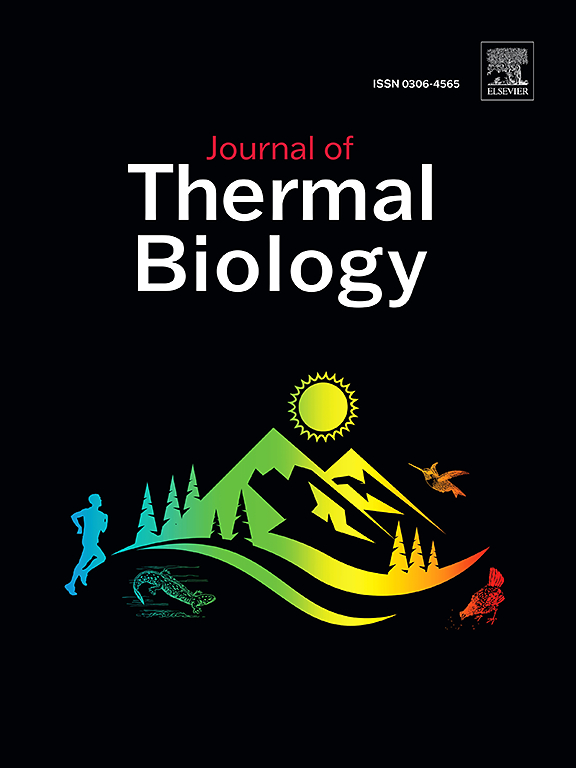Reduced thermoregulatory ability contributes to increased mortality in urban box turtles (Terrapene spp.)
IF 2.9
2区 生物学
Q2 BIOLOGY
引用次数: 0
Abstract
Urban wildlife often shows pronounced differences in ecology, behavior, and survival compared to rural individuals. Given the broad impacts of temperature in ecology, thermal discrepancies between cities and their rural surroundings are likely to play a major role in explaining these differences between urban and rural animals. Although experimental work has demonstrated the impacts of urban temperatures on wildlife, we lack field data on the body temperatures of free-living urban animals and the ecological impacts of these temperatures. In addition, while urban heat islands have directed research towards the impacts of warmer temperatures, relatively little focus has been given to the potential for urban organisms to experience colder temperatures. Here, we use 10 years of data to show that box turtles (Terrapene spp.) in an urban park are less effective thermoregulators than their rural counterparts at both hot and cold temperature extremes. In contrast to the heat island effect, the body temperatures of brumating urban box turtles are colder and more variable in the winter compared to rural turtles, despite similar environmental temperatures. Furthermore, during the hottest months we find no evidence of an urban heat island effect, yet body temperatures of urban turtles are hotter than rural turtles. These body temperature differences suggest that urban turtles have a reduced ability for behavioral thermoregulation, likely due to lower habitat quality and reduced movement capacity in the urban environment. We further show that turtles experiencing extremely cold body temperatures in the winter are less likely to survive the subsequent year, indicating that over-winter thermoregulatory ability could play an under-appreciated role in the fitness and abundance of urban ectotherms. As urbanization continues to degrade landscapes and as climate change increases the occurrence of temperature extremes, we highlight the need to understand the impacts of cold temperatures on wildlife in human-altered environments.
城市箱龟(Terrapene spp.)体温调节能力降低导致死亡率增加。
城市野生动物与农村野生动物相比,在生态、行为和生存方面往往表现出明显的差异。考虑到温度对生态的广泛影响,城市和农村环境之间的温度差异可能在解释城市和农村动物之间的这些差异方面发挥了主要作用。虽然实验工作已经证明了城市温度对野生动物的影响,但我们缺乏关于自由生活的城市动物体温和这些温度对生态影响的实地数据。此外,虽然城市热岛已经将研究引向了温度升高的影响,但相对而言,很少有人关注城市生物经历较冷温度的可能性。在这里,我们使用了10年的数据来表明,在城市公园里的箱龟(Terrapene spp.)在极端高温和极端寒冷的温度下都不如农村的箱龟有效地调节温度。与热岛效应相反,尽管环境温度相似,但与农村龟相比,冬眠的城市箱龟的体温在冬季更冷,变化更大。此外,在最热的月份,我们没有发现城市热岛效应的证据,但城市龟的体温比农村龟高。这些体温差异表明,城市龟的行为体温调节能力较弱,可能是由于栖息地质量较低,城市环境中的运动能力降低。我们进一步表明,在冬季经历极低体温的海龟在接下来的一年里不太可能存活,这表明越冬温度调节能力可能在城市变温动物的适应性和丰度中发挥了未被充分认识的作用。随着城市化继续使景观退化,随着气候变化增加极端温度的发生,我们强调有必要了解在人类改变的环境中低温对野生动物的影响。
本文章由计算机程序翻译,如有差异,请以英文原文为准。
求助全文
约1分钟内获得全文
求助全文
来源期刊

Journal of thermal biology
生物-动物学
CiteScore
5.30
自引率
7.40%
发文量
196
审稿时长
14.5 weeks
期刊介绍:
The Journal of Thermal Biology publishes articles that advance our knowledge on the ways and mechanisms through which temperature affects man and animals. This includes studies of their responses to these effects and on the ecological consequences. Directly relevant to this theme are:
• The mechanisms of thermal limitation, heat and cold injury, and the resistance of organisms to extremes of temperature
• The mechanisms involved in acclimation, acclimatization and evolutionary adaptation to temperature
• Mechanisms underlying the patterns of hibernation, torpor, dormancy, aestivation and diapause
• Effects of temperature on reproduction and development, growth, ageing and life-span
• Studies on modelling heat transfer between organisms and their environment
• The contributions of temperature to effects of climate change on animal species and man
• Studies of conservation biology and physiology related to temperature
• Behavioural and physiological regulation of body temperature including its pathophysiology and fever
• Medical applications of hypo- and hyperthermia
Article types:
• Original articles
• Review articles
 求助内容:
求助内容: 应助结果提醒方式:
应助结果提醒方式:


